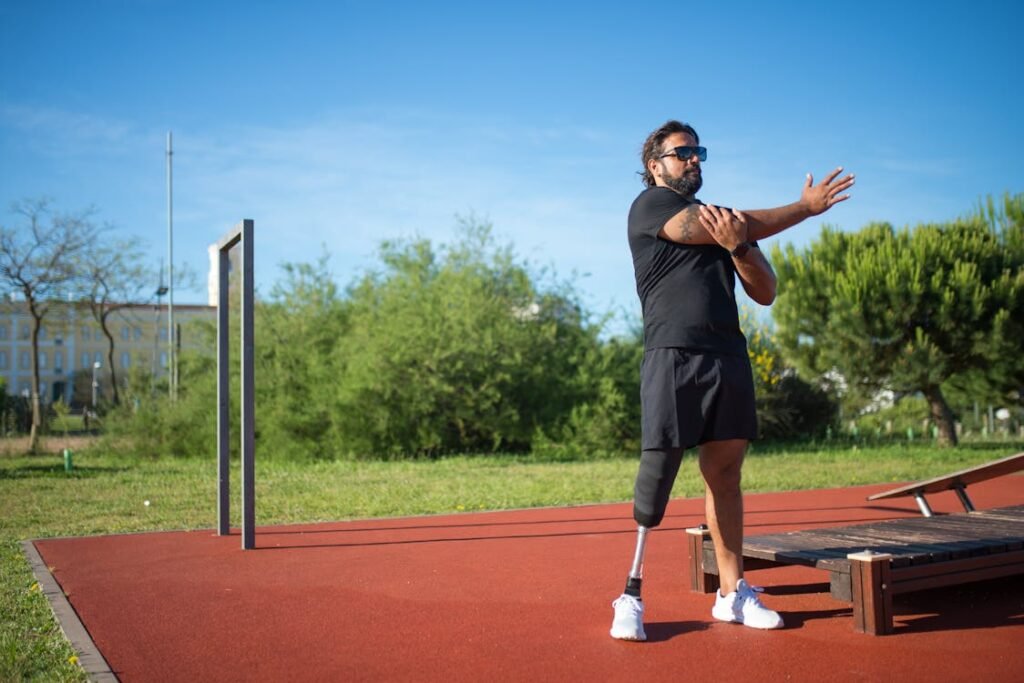Losing a leg is a life-changing experience, but modern prosthetic technology has made it possible for people to regain mobility and independence. Whether it’s walking, running, or even climbing stairs, prosthetic legs help individuals move forward—both physically and emotionally. But when it comes to choosing the right prosthetic, there are two main types: bionic legs and traditional prosthetic legs.
Both options serve the same purpose—to replace the lost limb—but they work in very different ways. A traditional prosthetic leg is a mechanical device that helps users move with the help of their own strength and balance. A bionic leg, on the other hand, uses advanced technology, sensors, and motors to mimic natural movement more closely.
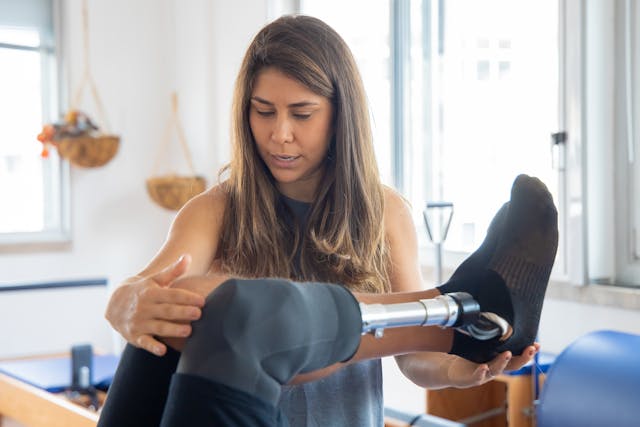
Understanding Traditional Prosthetic Legs
A traditional prosthetic leg is designed to help people walk and move by replacing the missing limb with a mechanical substitute. These prosthetics do not have any electronic components or powered parts.
Instead, they rely on the user’s own strength, balance, and movement to function. For decades, traditional prosthetic legs have been the go-to solution for individuals with limb loss, offering them a way to regain mobility and perform daily activities.
How Traditional Prosthetic Legs Work
The basic structure of a traditional prosthetic leg consists of a socket, a pylon (which acts as the leg’s framework), and a foot. The socket is custom-fitted to the residual limb, ensuring a snug and comfortable fit.
The pylon is usually made from lightweight materials such as carbon fiber or aluminum, providing strength without adding unnecessary weight. The foot may be made of flexible materials that allow some degree of movement, helping users achieve a more natural gait.
Since traditional prosthetics do not have electronic or motorized components, the user has to control every movement manually. Walking with a traditional prosthetic requires practice, as users need to develop balance and coordination.
The absence of powered assistance means that activities like climbing stairs, walking on uneven ground, or running require significant effort and energy. Over time, users can adapt, but it often involves a learning curve and physical conditioning.
Benefits of Traditional Prosthetic Legs
One of the biggest advantages of traditional prosthetic legs is their durability. Since they do not have electrical components, they are less prone to malfunctions and require minimal maintenance.
Users can rely on them in various environments without worrying about battery life, software issues, or mechanical failures.
They are also significantly more affordable than bionic legs, making them a practical choice for individuals who may not have access to high-end prosthetic technology.
Traditional prosthetics are also available in a wide range of designs. Some are made specifically for everyday use, while others are designed for high-performance activities such as running or swimming.
Athletes with limb loss often use specialized prosthetic legs made from advanced carbon fiber materials that offer improved flexibility and energy return. These variations provide users with the flexibility to choose a prosthetic that suits their lifestyle and mobility goals.
Challenges of Traditional Prosthetic Legs
Despite their benefits, traditional prosthetic legs have limitations. Since they do not replicate the natural movement of a human leg, they require more effort to use.
Users often experience muscle fatigue, especially during extended periods of walking or standing.
The lack of advanced sensors and microprocessors means that traditional prosthetics do not automatically adjust to different terrains or movements, making tasks like walking uphill or on uneven surfaces more challenging.
Another issue some users face is discomfort. The socket, which connects the prosthetic to the body, needs to fit perfectly to prevent irritation and pressure sores.
If the socket does not fit well, it can cause pain, making it difficult to wear the prosthetic for long hours. Frequent adjustments or even replacements may be necessary to maintain comfort and functionality.

Understanding Bionic Legs
Bionic legs represent the next level of prosthetic technology. Unlike traditional prosthetic legs, which rely solely on the user’s physical effort, bionic legs are powered by advanced sensors, microprocessors, and motors that allow them to move in a way that mimics natural human walking.
These high-tech prosthetics are designed to adapt to different environments, respond to movement changes, and provide users with a smoother, more effortless walking experience.
How Bionic Legs Work
The key feature that sets bionic legs apart is their ability to detect and respond to movement in real time. They are equipped with sensors that analyze the user’s gait, pressure, and speed.
These sensors send signals to an embedded microprocessor, which processes the data and adjusts the prosthetic’s movement accordingly. This allows the bionic leg to adapt to different walking speeds, uneven surfaces, and even activities like climbing stairs.
Some bionic legs go a step further by integrating myoelectric technology, which means they can receive signals from the user’s muscles.
Electrodes placed on the residual limb detect muscle movements, allowing the prosthetic to move in sync with the user’s intentions. This creates a more natural walking experience, reducing the effort required and making movement feel seamless.
Bionic legs are also powered by battery-operated motors that provide additional support when walking. These motors help lift the leg and propel the user forward, significantly reducing the strain on the rest of the body.
Instead of having to manually lift and swing the prosthetic with each step, the motor assists with movement, making walking less tiring and more efficient.
Benefits of Bionic Legs
One of the biggest advantages of bionic legs is the improved natural movement and adaptability. Traditional prosthetics require constant conscious effort to walk, but bionic legs adjust automatically.
This makes them an excellent option for people who want to move more comfortably, navigate different terrains with ease, and reduce overall fatigue.
Another major benefit is the enhanced stability and safety they offer. Since bionic legs can detect changes in movement and react in real time, they help prevent falls and stumbles.
For example, if a user steps onto an uneven surface, the sensors in the leg adjust the foot’s angle to provide better balance. This makes a huge difference for users who want to move around confidently without constantly worrying about tripping or losing stability.
Bionic legs also offer a more intuitive walking experience. Because they can sync with muscle movements and automatically adjust to the user’s gait, they require less effort to operate.
This is especially helpful for individuals who have experienced recent limb loss and are still adapting to using a prosthetic. The smoother movement means less strain on the hips and back, reducing long-term physical stress on the body.
Challenges of Bionic Legs
Despite their impressive technology, bionic legs come with a few drawbacks. One of the main challenges is cost. These prosthetics are significantly more expensive than traditional legs due to the advanced materials, microprocessors, and motorized components.
The high price can be a barrier for many individuals, especially in countries where insurance coverage for prosthetic devices is limited.
Another consideration is maintenance and battery life. Unlike traditional prosthetics, which require little upkeep, bionic legs depend on electronics that need regular maintenance and software updates.
Users must charge their prosthetic regularly, and if the battery runs out during the day, the leg may lose functionality until recharged. Additionally, repairs can be more complex and costly since specialized parts and technicians are required.
While bionic legs offer incredible mobility, they also require training and adaptation. Since they function differently from traditional prosthetics, users often need time to get used to how they work.
Some may require rehabilitation or physiotherapy sessions to learn how to walk naturally with their new limb. However, once they become accustomed to the technology, most users find that the benefits far outweigh the initial challenges.
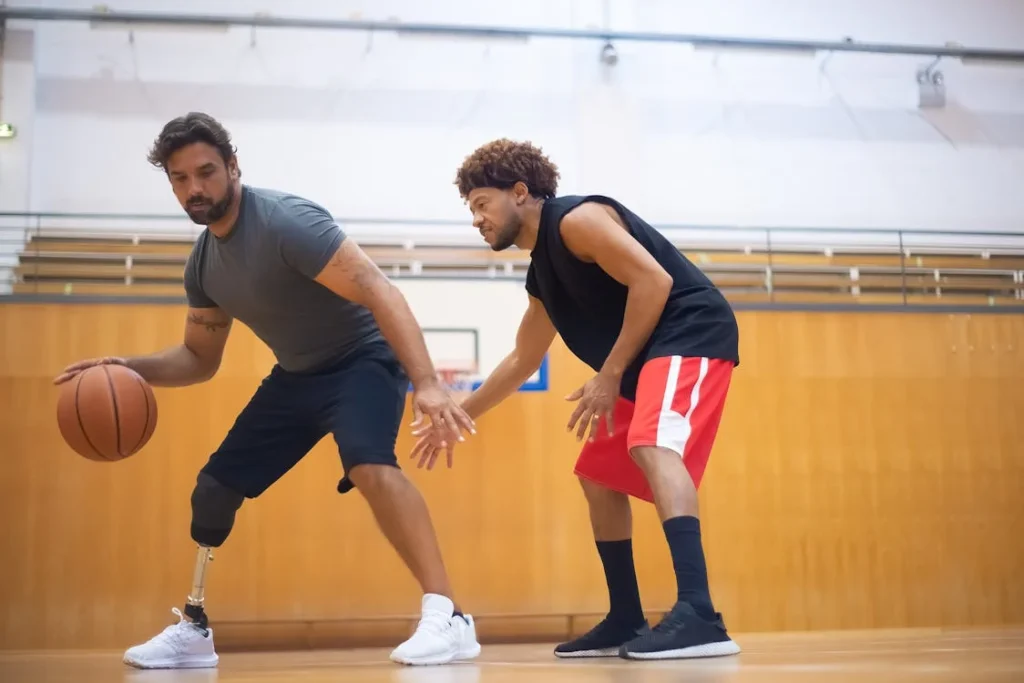
Comparing Bionic Legs and Traditional Prosthetic Legs
Choosing between a bionic leg and a traditional prosthetic leg depends on multiple factors, including lifestyle, budget, and personal preferences.
While both serve the same fundamental purpose of restoring mobility, they function in very different ways and offer distinct advantages and challenges. Understanding these differences can help users make a more informed decision.
Movement and Control
One of the biggest differences between the two is how they move. Traditional prosthetic legs require the user to control every movement manually.
This means walking, climbing stairs, and adjusting to different terrains all depend on the user’s balance, strength, and coordination. Over time, users can learn to walk smoothly, but the process takes effort and practice.
Bionic legs, on the other hand, are designed to move more naturally. Sensors and microprocessors analyze the user’s gait and adjust the prosthetic’s motion in real time. Some models can even sync with muscle signals, allowing movement to feel more intuitive.
Because of this, walking with a bionic leg is usually easier and requires less physical effort. Users experience smoother transitions between steps and can move with greater confidence.
Comfort and Adaptability
Comfort is a key factor when choosing a prosthetic leg. Traditional prosthetics rely on a well-fitted socket to stay secure. If the fit is not perfect, users may experience discomfort, skin irritation, or even pain.
Since traditional prosthetics do not automatically adjust to movements, they can put extra strain on the residual limb and surrounding muscles. Over time, this can lead to fatigue, soreness, or posture imbalances.
Bionic legs are designed to adapt. Because they adjust based on the user’s movement, they provide a more natural walking experience with less impact on the body.
The way they distribute weight and pressure can help reduce discomfort, making them easier to wear for long periods.
However, some users may need time to adjust to the new sensations of a bionic leg, as the powered components function differently from a traditional mechanical limb.
Stability and Safety
Traditional prosthetic legs provide stability, but they require the user to maintain balance manually. Walking on uneven terrain, going up and down stairs, or adjusting to sudden changes in movement can be more challenging.
Many users develop strong compensatory movements to stay balanced, but this can lead to strain on other parts of the body.
Bionic legs improve stability by making real-time adjustments. If a user steps onto an incline, the sensors detect the change and adjust the angle of the foot.
Some models even provide powered assistance for stepping up onto a curb or climbing stairs. This added control helps reduce the risk of falls and gives users more confidence when navigating different environments.
Energy and Effort
Using a traditional prosthetic leg requires significant physical effort. Since all movements are controlled manually, users need to engage their muscles constantly to walk, balance, and adjust to terrain changes.
This can lead to fatigue, especially for those who need to move frequently throughout the day.
Bionic legs reduce the energy needed for movement. Because they provide powered assistance, they help lift and propel the leg forward with each step.
This reduces strain on the rest of the body and allows users to walk for longer periods without feeling as tired. For individuals with limited strength or endurance, this can make a huge difference in daily mobility.
Cost and Maintenance
Traditional prosthetic legs are more affordable and require minimal maintenance. They do not rely on batteries or electronics, so there are fewer parts that can break or malfunction.
Repairs and adjustments are generally straightforward, and users do not need to worry about software updates or charging their device.
Bionic legs are significantly more expensive due to the advanced technology they contain. The cost includes not only the prosthetic itself but also ongoing maintenance, software updates, and potential repairs.
Since these legs run on battery power, users need to ensure they are charged regularly to avoid losing functionality. In some cases, specialized technicians are needed for repairs, which can add to the overall cost of ownership.
Learning Curve and Adaptation
Both types of prosthetic legs require an adjustment period, but the learning process is different. With traditional prosthetics, users must train their muscles and balance to walk effectively. This often involves physical therapy and practice to develop a smooth gait.
Bionic legs may be easier to walk with once a user gets accustomed to them, but they also require training. Users need to learn how the prosthetic responds to their movements and may need guided rehabilitation to take full advantage of the technology.
Once they become comfortable, however, most find that bionic legs offer a more natural and effortless walking experience.
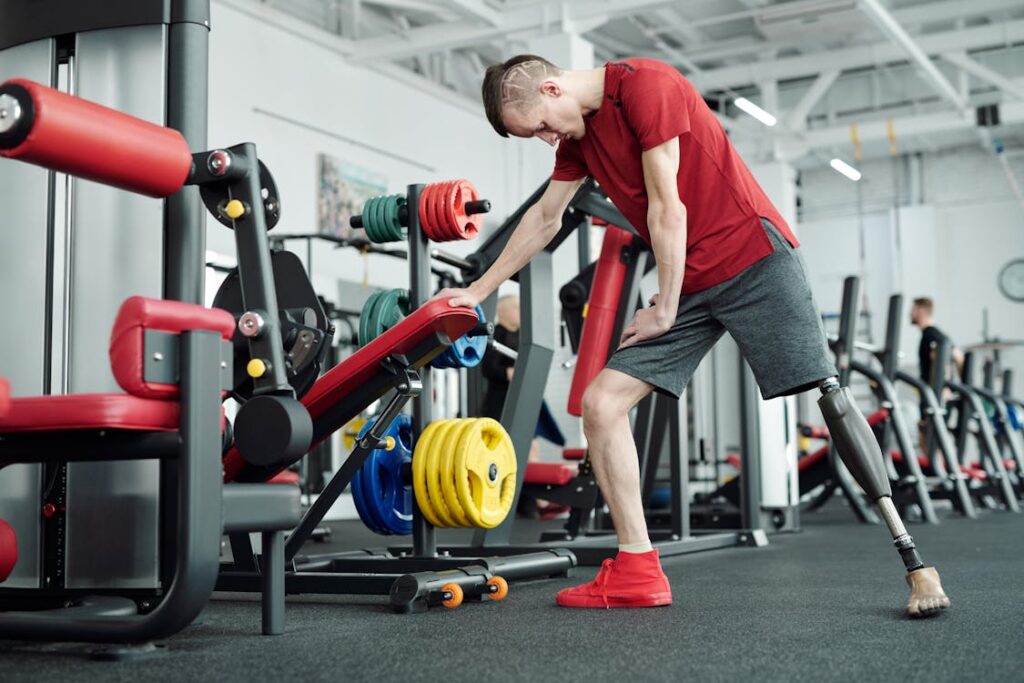
Psychological and Emotional Impact of Using Bionic vs. Traditional Prosthetic Legs
Beyond movement and mechanics, the choice between a bionic leg and a traditional prosthetic leg also affects a person’s emotions, confidence, and overall well-being.
Mobility plays a crucial role in how individuals interact with the world, and the right prosthetic can make a significant difference in how someone feels about themselves and their independence.
Confidence and Self-Perception
Losing a limb is not just a physical change; it also impacts how individuals see themselves. Many prosthetic users go through a period of emotional adjustment, learning to accept their new reality and regain confidence.
Traditional prosthetic legs, while functional, do not always feel like a natural part of the body. Users often have to put in extra effort to walk smoothly, and some may feel self-conscious about the visible mechanics of the prosthetic.
Bionic legs offer a different experience. Because they mimic natural movement and respond intuitively to the user’s body, they can feel more like an extension of oneself rather than just a tool.
This can have a profound impact on confidence, as users may feel more in control of their movement and less limited by their prosthetic. The ability to walk more effortlessly and move with greater ease can improve self-esteem and encourage users to engage more in social activities.
Social Interactions and Public Perception
How a prosthetic leg is perceived by others can also influence a user’s confidence. Traditional prosthetic legs, while effective, can sometimes draw attention due to their mechanical nature.
Some users embrace this, proudly displaying their prosthetic as a part of their identity, while others may feel self-conscious about standing out.
Bionic legs, being more advanced, often generate curiosity and admiration. Many people are fascinated by the technology and see bionic limbs as a symbol of progress and resilience.
Some users find this empowering, as their prosthetic becomes not just a medical device, but a representation of strength and innovation. However, this attention can also feel overwhelming for individuals who prefer to blend in rather than stand out.
Independence and Quality of Life
The level of independence a prosthetic provides has a direct impact on emotional well-being. Traditional prosthetic legs require the user to be mindful of every step they take, which can sometimes lead to frustration, especially in complex environments.
The need for constant balance adjustments and physical effort can make daily activities feel more exhausting, potentially limiting what users feel comfortable doing.
Bionic legs, with their ability to adapt and assist movement, often make users feel more independent. The reduced physical strain allows for greater ease in everyday tasks, whether it’s walking through a crowded area, climbing stairs, or standing for long periods.
This increased freedom can lead to a better quality of life, as users feel less restricted by their prosthetic and more in control of their daily experiences.
Emotional Adjustment and Mental Health
Adjusting to any prosthetic leg—whether traditional or bionic—takes time. The emotional journey of learning to walk again can be challenging, filled with both progress and setbacks. Some individuals experience frustration, impatience, or even grief over the loss of their natural limb.
For those using traditional prosthetic legs, the adjustment process may involve more physical challenges, as they must train their bodies to work harder to compensate for the lack of powered assistance.
This can lead to moments of discouragement, especially when facing difficulties with balance or fatigue. However, many users develop a deep sense of resilience and pride in their ability to master their prosthetic through sheer determination.
Bionic leg users, while benefiting from technological advancements, also face an adjustment period. The learning curve with a robotic limb can be steep, requiring patience and adaptation.
Some users feel a disconnect initially, as the technology-driven movement of the leg may feel unfamiliar. Over time, however, many report feeling a stronger connection to their prosthetic, as it becomes an integral part of their mobility and self-expression.
The Role of Support and Rehabilitation
Regardless of whether someone chooses a bionic or traditional prosthetic leg, emotional and psychological support is crucial. Having access to rehabilitation programs, peer support groups, and counseling can make the transition smoother.
Many prosthetic users find comfort in connecting with others who have gone through similar experiences, sharing advice, and learning from one another.
At Robobionics, we understand that adjusting to a prosthetic is more than just a physical challenge—it’s a full-body and emotional journey.
That’s why we offer gamified rehabilitation programs that not only help users adapt to their prosthetics but also make the process more engaging and motivating.
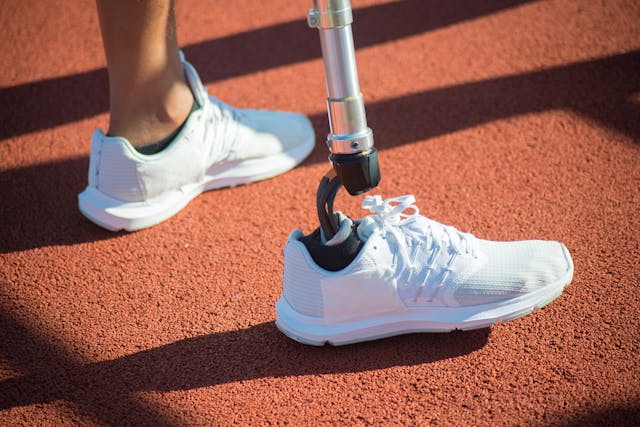
The Future of Prosthetic Leg Technology
The world of prosthetic legs has evolved rapidly in recent years, and the advancements in both traditional and bionic prosthetics show no signs of slowing down.
Innovations in materials, artificial intelligence, and biomechanical engineering are transforming how prosthetic limbs function, making them more efficient, comfortable, and personalized than ever before.
The future of prosthetic technology is not just about replacing lost limbs—it’s about enhancing human potential.
Smart Prosthetics with AI and Machine Learning
One of the most exciting developments in bionic prosthetics is the integration of artificial intelligence and machine learning.
Current bionic legs already use sensors and microprocessors to adjust movements in real time, but future models are expected to learn from the user’s behavior and automatically optimize performance.
AI-powered prosthetics will be able to analyze walking patterns, predict movement intentions, and adjust responses based on past behavior.
Over time, these devices could become even more intuitive, allowing users to move in a way that feels increasingly natural. This would drastically reduce the learning curve and make adapting to a prosthetic much smoother.
Neural-Controlled Prosthetics
A major breakthrough in prosthetic technology is the development of mind-controlled limbs. Researchers are working on neural interfaces that allow prosthetic legs to connect directly with the brain, enabling users to control their movement using their thoughts.
Instead of relying on muscle sensors or external controls, these prosthetics would function as an extension of the body, responding instantly to mental commands.
Some experimental prosthetic legs already use brain-computer interfaces (BCIs) to detect neural signals and translate them into movement.
While these technologies are still in the early stages, they have the potential to revolutionize mobility for amputees, offering a level of control and fluidity that was previously unimaginable.
Self-Healing and Adaptive Materials
The materials used in prosthetic legs are also evolving. Future prosthetics may incorporate self-healing materials that can repair small cracks or wear over time, reducing the need for frequent maintenance and replacements.
Researchers are also exploring adaptive materials that can change shape and stiffness based on activity. For example, a prosthetic leg could become more flexible when running and then stiffen for stability when standing still.
Advances in 3D printing are making prosthetic legs more accessible and customizable. At Robobionics, we already use lightweight, ergonomic 3D-printed designs to create prosthetics that fit users perfectly.
In the future, 3D printing could allow for on-demand, highly personalized prosthetics that match a person’s exact limb structure and movement needs.
Energy Harvesting for Continuous Power
One challenge of bionic legs is the need for battery power. Current models require regular charging, which can be inconvenient for users.
However, future prosthetic legs may be able to generate their own power using energy-harvesting technology. By capturing energy from walking, heat, or movement, these prosthetics could stay powered without needing frequent charging.
Some researchers are even exploring ways to integrate solar cells or body heat conversion into prosthetic designs, allowing users to generate electricity simply by going about their daily activities.
This would make bionic legs more reliable and reduce the dependency on external charging sources.
The Role of Robotics in Prosthetic Evolution
Robotics is playing a crucial role in the next generation of prosthetic legs. Engineers are developing robotic joints and exoskeleton-style prosthetics that provide even greater mobility and strength.
Some robotic prosthetics already include powered knee and ankle joints, which allow users to walk with greater ease and efficiency.
As robotics and prosthetics continue to merge, we could see the development of fully automated prosthetic limbs that react instantly to the environment.
For example, a future prosthetic leg could sense when the user is about to slip and adjust its position to prevent a fall. These advancements will push the boundaries of what prosthetic limbs can achieve, making them more responsive and human-like than ever before.
The Future of Prosthetic Accessibility
With all these innovations on the horizon, one of the most important goals is making advanced prosthetics more affordable and widely available.
Currently, bionic legs are expensive and not always accessible to those who need them. However, as technology advances and manufacturing costs decrease, we can expect to see more affordable, high-tech prosthetic options reaching a larger population.
At Robobionics, we are committed to developing prosthetics that are not only advanced but also accessible to people in India and beyond.
Our focus on locally designed, high-quality prosthetics ensures that users receive the best possible solutions without the high costs associated with imported devices.
The future of prosthetic legs is bright, and as technology continues to evolve, the gap between human and artificial limbs will continue to shrink. The goal is not just to restore lost function but to enhance mobility, independence, and overall quality of life for every user.

Conclusion
Choosing between a bionic leg and a traditional prosthetic leg depends on individual needs, lifestyle, and budget. Traditional prosthetic legs offer durability, affordability, and reliability, making them a practical choice for many users. However, they require more physical effort and adaptation. Bionic legs, with their advanced technology, provide a more natural walking experience, greater comfort, and improved stability, but they come with higher costs and maintenance needs.
Beyond function, the psychological impact of a prosthetic leg plays a crucial role in confidence, independence, and overall well-being. The future of prosthetic technology is evolving rapidly, with innovations in AI, neural control, adaptive materials, and self-powering systems making artificial limbs more intuitive and accessible.
At Robobionics, we are committed to developing high-quality, locally designed prosthetics that empower users to regain independence and live life without limits. Whether you’re looking for a traditional prosthetic or an advanced bionic solution, we’re here to guide you every step of the way.
Book a free consultation today to explore the best prosthetic option for you and take the next step toward effortless mobility.



